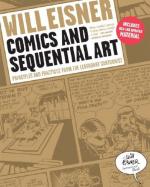
|
| Name: _________________________ | Period: ___________________ |
This test consists of 5 multiple choice questions, 5 short answer questions, and 10 short essay questions.
Multiple Choice Questions
1. What does Eisner think light implies?
(a) Fear.
(b) Love.
(c) Safety.
(d) Comfort.
2. What kinds of tasks are by nature, sequential?
(a) Guidelines and perspective.
(b) Procedures and processes.
(c) Chores and language.
(d) Thoughts and actions.
3. How many points does Eisner say an artist must understand about how objects work?
(a) Ten.
(b) Six.
(c) Five.
(d) Eleven.
4. What is the face sometimes treated as?
(a) An appendage.
(b) A blight.
(c) A ligament.
(d) A facet.
5. What other method requires production of a paperboard with colors added to transparent overlays?
(a) Red line.
(b) Black line.
(c) Green line.
(d) Blue line.
Short Answer Questions
1. What do most humans understand the face as?
2. What does Eisner flatly declare about the relationship between artist and writer?
3. Why is the face the most important part of the body in comics?
4. What can artists be tempted to do to detract from the storyline?
5. What is the title of Chapter 7?
Short Essay Questions
1. Contrast gesture and posture.
2. Why do purely instructional comics often use humor?
3. Give a brief synopsis of Chapter 8.
4. Why do people make important daily judgments about faces?
5. How can the artist successfully convey an image of the human body?
6. How are comic book artists most challenged in portraying amorphics?
7. Why must frozen moments convey both time and emotion?
8. Name four of the eleven points Eisner covers, because he thinks an artist must understand about how objects work in order to portray them skillfully.
9. How can posture and gesture give insight into a character's lifestyle and allow sociological observations?
10. Why does Eisner reproduce the story written by Jules Feiffer that was never published?
|
This section contains 782 words (approx. 3 pages at 300 words per page) |

|




